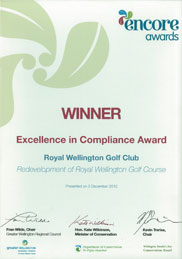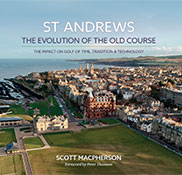GOLF CHAMPIONSHIPS ON SMGD COURSES:
At Close House – Colt Course. Sept 2017. A prestigious European Tour Championship hosted by Lee Westwood.
Broadcast worldwide from Royal Wellington Golf Club, NZ. October 2017. WOW!
The legacy continues.
Co-hosted at the award-winning Millbrook Resort near Queenstown, NZ. 2014 – 2023.
Design Principles
The principles of golf course design must be such that they aim to produce a golf course that engages the golfer, affords a high level of entertainment, provides a pleasant journey and enriches the lives of those who play. The course should be able to accommodate large numbers of golfers safely, be manageable and maintainable within the budget and resources of the club, and be a positive contributor to the environment.
Research is clear that the majority of golfers who play the game only display an average ability, but continue to return due to the pleasantness of the social aspects, and the beauty of the outdoor surroundings. If the course has wide landing areas, ample greens area to permit a range of flag placements, and gentle flow to play it will almost certainly be conducive to enjoyable golf.
My principles for great golf course design are based on four corner stones:
1. Providing an interesting, exciting and expressive golf course.
2. Designing a course to meet the business needs of the client.
3. Satisfying the foreseen desires of the community now and into the future.
4. Improving the environment to provide viable ecosystems and habitat for wildlife.
1. Providing an interesting, exciting and expressive golf course for all.
Master Planning
The success of any golf course is reliant upon competent master planning. It is most ideal if the golf course architect is involved with the master planning from the initial stages of the project to ensure the area for the golf course is compatible with golf. If they are, even with an average landscape, it should be possible to produce a first rate golf course. If this is not possible, it is likely the quality of the golf course may be compromised.
Once the boundary’s of the property have been established, and the area for the golf course is finalised, the golf course architect must set to work identifying the best clubhouse and practice area location, and planning the journey the golf course will take around the property. Ideally the clubhouse will be in a reasonably central place that allows the first hole to play away from the morning sun, and the last hole to play away from the setting sun. There must also be good access to the building for the patrons and deliveries. If the practice range is located within a short walk from the Clubhouse, that is ideal. In addition, it is preferred if the last hole does not play up an excessive hill – this can be exhausting to golfers at the end of a round of golf.
The configuration of the holes may change. It is best if an 18-hole course is made up of two loops of nine holes with both starting close to and finishing nearby the clubhouse. This is especially important if the course is for a resort, where two tee starts are needed, or if golfers only want to play nine holes.
Hole Length Planning
- The starting place for the configuration of the course should be to have an 18-hole with a par of 72. Should there be good reasons to move away from this formula, such as the shape of the property, or to utilise an outstanding natural feature, this should be done.
- An 18-hole course should have elasticity of length. Through the use of varying teeing grounds (a minimum of three per hole), the course may stretch from 5000 yards to 7,400 yards. This range should allow for advancements in an individuals golfing ability (or a decrease for that matter), for future proofing the course for developments in the balls an implements and so a course can be set-up up differently in varying winds and seasons ) i.e. lengthen the course when the ground is firm, shorten it when the ground is damp)
- The length of the front nine and back nine should match each other as close as possible in length and par.
- If it is an 18-hole course it should have 4 par three’s, 4 par 5’s and 10 par 4’s. This guideline can also be changed if good reason necessitates, but if it prevails, it is ideal if the holes within each category are varied in length. E.g.
- Par 3’s; Two holes between 140-175 yards, two holes between 175-240 yards
- Par 4’s; 2 Holes between 290- 340 yards, the remaining holes as necessary to fit the landform, but should not exceed 500 yards.
- Par 5’s; Two holes between 480- 530 yards, and two holes between 530 and 650 yards.
- The long and short holes should, in an ideal routing, be peppered between the par 4’s. Ideally the course does not start or finish on a Par 3.
- The first and tenth hole should permit golfers to move forward free from excessive difficulties. Failure to allow this will slow down the speed of play. In addition, it is ideal if these tees can be seen from the Starters box.
- Within the last four holes of the course, it would ideal to have at least one short hole and one long hole. The last two holes would ideally require at least two shorts to reach the green.
- The course routing should be such that the holes play in all the directions of the compass. It should be avoided if possible for hole to run parallel to each other.
Tees
- There should be a variety of tees on each hole. Depending on the type of course, this may be a minimum of threes sets and possibly up to five sets.
- The tees should ideally be off-set to each other.
- The area of the tees should be;
- Par 3’s = 740 square Metres (8000 square feet)
- Par 4’s and 5’s = 560 square Metres (6000 square feet)
- The forward and rear tees should be smaller than the main tee. If there are only three tees, the split may be 25% of the area is afforded to the front and back tee and 50% to the middle tee. If there are four tees, it may be that 30% of the teeing area is set aside for the front and back tee and 70% reserved for the two middle tees.
- All tees should be set as low to the ground as possible, but not have any water running on to them.
- All tees must have a minimum slope to allow for surface drainage. The pitch of the slope may be left to right or right to left. In addition the tee may have front to back if the tee shot is uphill, or slope from the back to front it the tee shot is downhill. Most slopes shall be 1.5%
- Drainage shall be cut into this base. After the drainage is install the entire tee shall be covered in a minimum of 100mm of sand/rootzone on top.
- Tees should be constructed in places where they will receive full sun for much if not all of the day. Shade and poor air circulation will be detrimental to the growth of the turf.
Greens
- The greens are the most important feature of each golf course.
- Greens should not be over-contoured. Such greens introduce an element of luck to the game that detracts from the advancement of skill. The greens should provide different challenges. They should be positioned in a variety of places, and designed in a variety of shapes and sizes.
- The minimum size of a green shall be 500m2, but ideally there would be approximately 400m2 of area on the green where a hole can be cut, meaning green areas may more average 600m2. There is no maximum size to a green but obviously the larger the green, the more they costs to build and maintain.
- The size of the greens is determined by several factors. Perhaps the most important are;
- The number of rounds on the course per year
- The internal contours of the greens
- The health of the turf grass.
- The amount of wear a green may get. (par three greens get a greater amount of wear so should be larger in size.)
- The number of pin positions required.
- The shape of the greens should all be different, and each green should provide visual and golfing interest.
- Good drainage is essential to increasing the life and health of the green. Ensure good drainage is installed.
- The rootzone material for the green itself shall have good percolation. The recommended minimum 13cm per hour.
- The slope within the areas where a hole can be cut shall not exceed 4%
- No trees should be within 30m of the edge of the green on the side where the rises, moves and sets during a day.
Fairways and roughs.
- The width of the fairway at the distance most golfers will hit the ball should be approximately 50-60m.
Features and Hazards
- As many existing features of the property should be incorporated into the routing. These may be stones walls, lakes, trees,
- Hazards- I like the edge of the hazard from which the golfer approaches it to be steep. This helps avoid an unfortunate lie on the margin of a hazard. In this regard, I also strongly prefer there to be no medium height of grass between the fairway and a bunker. If a ball is travelling towards a bunker, it should stop short or run into the hazard of its own accord.
- Hazards should be laid out in such a way that they positions on a fairway that make golfers think. Those who have the ability to find solutions to the puzzles gain the advantage, and those that do not receive the penalty by means of extra strokes.
Practice Facility
- The practice range should be located as close as possible to the driving range.
- For an 18-hole golf club, the practice range should be 70m wide and a minimum of 250m long. Ideally there would be extra length and if so, a second teeing area could be positioned at the opposite end.
- The teeing area should be at least 40m long and 25m deep to maximise turf regeneration.
- If there are holes, houses or any safety concerns parallel to the range, side-netting or screen planting should be considered.
- Consider planting artificial driving bays to eliminate turf damage especially in those parts of the country where turf regeneration and maintenance are a concern. If the bays with artificial turf are enclosed, the stations should be a minimum of 2.5m wide, 2,5m deep and have a roof that is 3.5m high. (NB_ This rook needs to be higher the more the pads are set back within the station). There should also be divider walls between the stations.
- If a practice putting green is to be built, this should be of the constructed with the same specification as the greens on the course. In terms of size, it should be approximately 1000m2, and located close to the clubhouse and 1st tees.
- Should a chipping green and practice green be required, they should also be constructed to the same specifications as the golf course. The area for the green should be approximately 550m2.
- Irrigation should be provided to all practice putting and chipping greens and to the practice tees.
Overall Design Strategy
- A golf course routing should be responsive to the character or the terrain on which it is laid-out.
- A golf course should present 18 holes that within a pre-determined design theme include a wide variety in their character. This variety can be made by making holes of different lengths, that play in varying directions, and utilise slopes in differing ways.
- The design of a hole should, as frequently as possible, have at least two ways to be played. The common alternatives are a longer but safer route and a sorter, more dangerous line that may result in the golfer gaining a stroke if their attempt is successful.
- The best golf courses are places where fun games can be enjoyed by golfers of all ages and abilities.
- The best golf courses have interesting features dotted along the line most golfers desire to play.
- Excessively punishing golfers repeatedly who are off-line creates little other than misery for them. Some courses like to punish golfers more when their indiscretion is greater, as happens in life. E.g Murder is punished more heavily in the judicial system than burglary. However, golf is unlike life in that in life one person can choose to live their life away from the mainstream. Golfers must start and finish in the centre so hazards placed centrally can never be avoided regardless of ones ability.
2. Designing a course to meet the business needs of the client
Different clients have different requirements for their golf course. The project could be a
- Private members facility.
- Resort course amenity. i.e. A golf course for a hotel, resort or vacation destination.
- A public recreational amenity- i.e. A community asset
- Residential development- i.e. An integrated golf course for a new development.
And within these design perimeters, the design brief could vary from high-end multi-course facility, to a9-hole pitch-and-putt course. The golf course could be private, semi-private or a public daily green fee course. Whatever the scope, it is important to understand the needs of the client.
Equally important is to understand the budget for the project. It may be that the client has not allowed sufficient funds to build the golf course they had required, but more likely that need advice on where the funds are required to ensure the golf course is of the quality desired. It is easy for money to be spent on the wrong things. And if money is tight, there are areas where money can be saved now, knowing future funding can
A failure to deliver a golf course on budget puts greater stress on the business to recoup the capital costs of construction.
Serious consideration must also be given to the design of the course in terms of the demands it will put on future maintenance. The consideration must extend from the tees with issues such as shading, to the fairway slopes, the design of the bunkers for edging, and sand splash and playability to the quality of the putting greens. Drainage will be one of the most important aspects too. No course will be suitable if it sits wet.
Failure by the architect to design a golf course that can be maintained within the budget may mean that either the design will not be maintain in a way that releases the full design characteristics of the course, of the quality of the playing conditions are sub-optimal. Neither scenario is good for the golf course owners business.
Turfgrass selection is a very important consideration. Turf growth is influenced by four factors; water, temperature, sun-light and nutrients (especially Nitrogen). Green keepers can only influence the water and nutrient components, so selecting a turf grass suitable to the prevailing temperature and sunlight conditions is very important. (NB- Cool season grasses have a lower light requirement, so this factor is rarely a consideration for them.)
3. Satisfying the foreseen desires of the community now and into the future.
There is an old Scottish saying that says ‘all people are equal when they stand over the ball’. Men, women, boys, girls, Kings, Knights, business and tradesmen, students etc. Golf is a game played by the greatest range of people and golf courses are the meeting grounds. At SMGD, it is believed that in considering a clients design brief, further thought should go into considering how different groups of the community might relate to and access the course. If we can create a golf course that encourages a wide spectrum of use and enjoyment for differing sectors of the community, there may be a greater opportunity for the success of the project.
Beyond the footprint of the course itself, there is often an opportunity to provide space for other pastimes such as cycling, walking, horse riding, boating, fishing etc. Master planning the property so the site may be utilised and enjoyed by various users provides the greatest flexibility for the project and the business.
4. Improving the environment to provide viable ecosystems and habitat for wildlife.
Golf courses have an opportunity to improve the environment. Some times this can be on a grand scale. e.g If the site is transferred from a mining quarry or landfill to a golf course, the improvements are obvious. Often the change of use on a site is less extreme, but still benefits are readily attainable. A key focus is water. For example, any water leaving the site should be cleaner than that entering the property. But a focus is also on the creation of habitats and ecosystems. The planting of trees and wildflowers in out-of-play areas creates food and nesting locations. Corridor and island habitats help the migration of birds and provide areas for breeding.
The first step to improving the environment is taking a holistic view to the master planning stage. Identifying such things as the water corridors, the protected or valuable habitats early on allows the routing of the golf course to best include these areas to ensure their longterm survival, viability and value.
We like to practice cost conservatism during construction. We practice this in two ways;
- In terms of the environment, we protect sensitive areas from the impacts of machinery
- It can be easy to spend money on items that may deliver little value to the client. So reducing earthworks can save money but can also mean the construction works have a smaller footprint, and thus less area is disturbed. This can be of significant importance when working in sensitive areas such as dune lands or wetlands, but beneficial everywhere.
Summary
Much thought goes into designing a golf course. Central to the design principles at SMGD is the desire to embrace the natural features of the property; to find the unique components to deliver the best golf course, improve the environment, and provide a facility that can be maintained and managed within the constraints of the business. If these principles are met, the result is almost certainly an attractive, interesting and successful golf course facility.
AWARDS
 Winner
Winner
Excellence in Compliance Award
Royal Wellington Golf Club
 Scott awarded by GEO as a Sustainable Golf Champion
Scott awarded by GEO as a Sustainable Golf Champion
PUBLICATIONS
 St Andrews
St Andrews
The Evolution of the Old Course
by Scott Macpherson
TESTIMONIALS
"RWGC set out to build the best club golf course in New Zealand and to be one that golfers from all around the world will travel to play. We are confident that ambition is being realized."
Peter Cutfield, Chairman, Royal Wellington Golf Club, NZ



